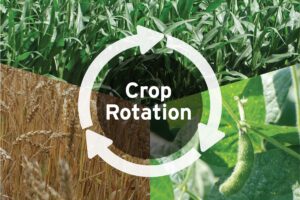A $27 billion industry
ONTARIO GRAIN AND OILSEED INDUSTRY CONTINUES TO GROW

THE NUMBERS ARE IN, AND THEY TELL AN EXCITING STORY about Ontario’s grain and oilseed industry: it is an economic juggernaut, with $27 billion in total economic output — representing a whopping 60 per cent increase since 2010.
That impressive statistic — and a whole lot more — detailed in the MNP report, Economic Impact Analysis of Grain Farming in Ontario, released in October of 2023, underscores just how important the grain and oilseed industry is to the Ontario economy.
“Grain farming in Ontario is vital to the economic success of the province,” says Brendan Byrne, chair, Grain Farmers of Ontario. “Our industry is a stable source of jobs and economic growth.”
REPORT HIGHLIGHTS
The MNP report shows significant growth in the economic impact of the grain and oil seed industry since 2010, including:
- $10.4 billion in total gross domestic product (GDP) — a 46 per cent increase
- $2.3 billion in total government revenue — a 64 per cent increase
- Providing more than 90,000 jobs in the province
Soybean production, the province’s largest crop by seeded acres, leads in direct economic output, with almost $3 billion, followed by corn, the province’s largest crop by volume, at
$2.7 billion. Wheat follows with $883 million, and barley and oats a combined $47 million in economic output.
However, the impacts along the value chain tell an even greater story: grain and oilseed milling provide $5.7 billion in direct economic output, with ‘basic chemical manufacturing’ representing $2.6 billion in economic output.
The transportation and wholesaling industry adds another $2.5 billion.
Direct output refers to the direct expenditures on goods and services made by grain and oilseed producers — such as machinery, fuel, and seed expenses, the employment of support staff and the generation of tax revenues for local, provincial, and federal governments. When indirect and induced impacts arising from the linkages that exist with suppliers and other industries are added to the total — soybean production’s total impact grows to $5.1 billion, corn $4.8 billion, wheat $1.5 billion, and barley and oats $81 million. The total economic impact along the value chain includes the milling industry, which represents nearly $7 billion, $3.6 billion in the ‘basic chemical manufacturing’ industry, and $4.6 billion in the transportation and wholesale industries.
Total direct, indirect, and induced full-time equivalent (FTE) jobs in Ontario created by the grain and oilseed industry include nearly 57,000 in the production of barley, corn, oats, soybeans, and wheat, more than 12,000 in manufacturing, and 22,650 in the transportation and wholesale industry.
To put the size of the Ontario grain and oilseed industry’s economic impact into perspective, the report made the following comparisons to other prominent Ontario industries:
- New home construction: The direct and indirect employment supported by the Ontario grain and oilseed farming value chain (77,950 FTEs) in 2022 is roughly equivalent to the employment supported by the construction of 38,780 new homes in Ontario. This is equivalent to approximately 40 per cent of new home starts in Ontario in 2022.
- Mining: The total employment supported by the Ontario grain and oilseed farming value chain (91,920 FTEs) in 2022 is roughly equivalent to the employment generated by the mining industry in Ontario.
- Forestry: The total employment supported by Ontario’s grain and oilseed farming value chain (91,920 FTEs) in 2022 is equivalent to about 60 per cent of the employment generated by the forestry industry in Ontario.
- Ontario GDP: The direct GDP generated by Ontario’s grain and oilseed farming value chain ($5.6 billion) in 2022 is equivalent to about 34 per cent of the total GDP ($16.6 billion) generated by these industries in Ontario.
TELLING THE STORY
Nearly 57,000 jobs are created in the production of barley, corn, oats, soybeans, and wheat, more than 12,000 in manufacturing, and 22,650 in the transportation and wholesale industry.
While grain and oilseed production provides huge economic benefits in Ontario, it does so with great risk to the farmers who grow Ontario’s barley, corn, oats, soybeans, and wheat, who face market volatility, rising input costs, impacts of weeds, pests, and disease, and uncertain weather.
“In order to ensure the sustainability of farming and food production, we need to work with government to ensure farmers can survive crises and keep growing food,” says Byrne. “Farmers need to be able to take risks and continue to be a leader in adopting innovation.”
In December 2023, Byrne, along with several Grain Farmers of Ontario directors and staff, took this message to Queen’s Park, sharing the report’s highlights with Premier Doug Ford and Ontario Minister of Agriculture, Food and Rural Affairs Lisa Thompson ahead of the Grain Farmers of Ontario Queen’s Park reception.
The annual reception gives Grain Farmers of Ontario the opportunity to meet with MPPs from all parties and Queen’s Park staffers. This year, they highlighted the good news in the MNP report and the need for continued investment in the sector.
“I know that our partners in government see these numbers and value farming and its contribution to the success of our province, and I look forward to working with them further,” says Byrne.
Read the full report at www.gfo.ca/economic-report. •

























